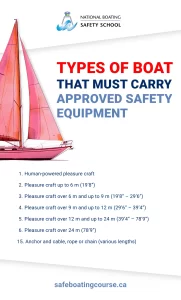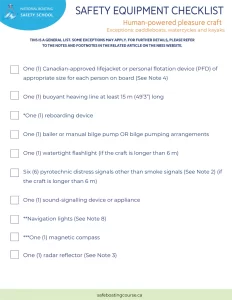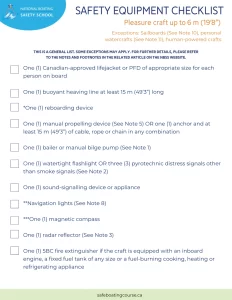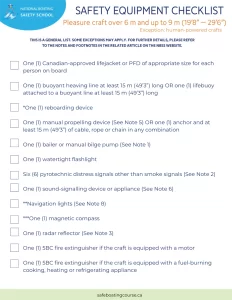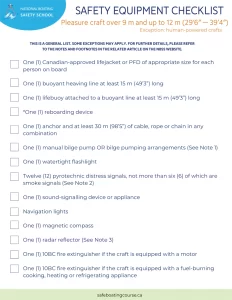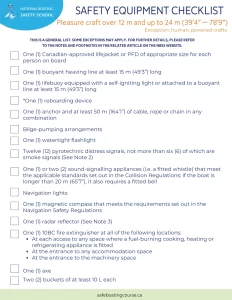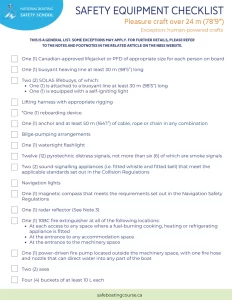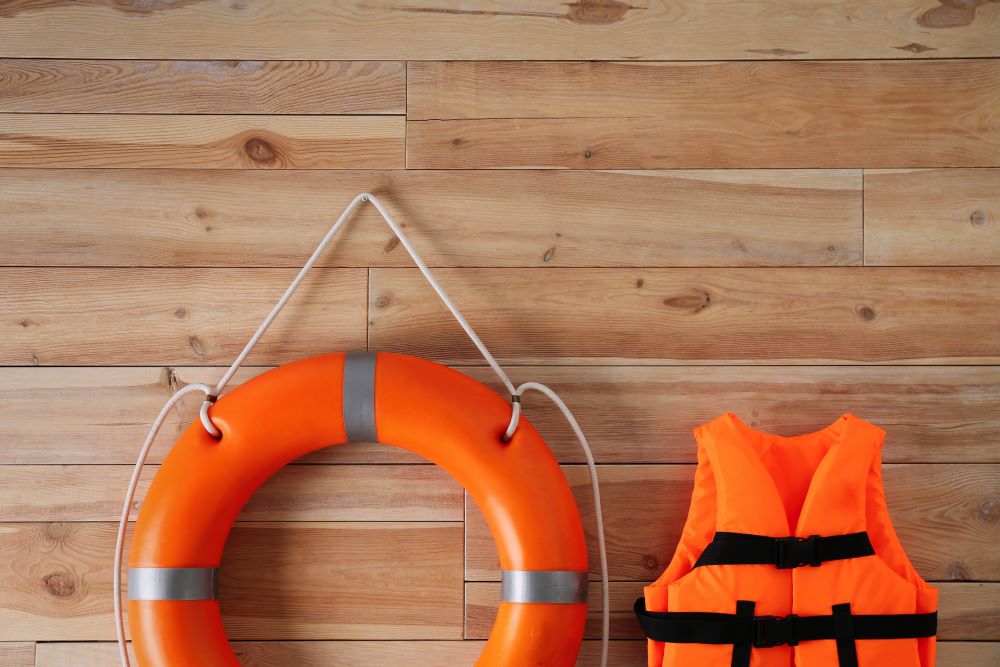
Boat Safety Equipment Checklist for Canadian Boaters
When operating a pleasure craft, you must have specific types of approved boating safety equipment and your pleasure craft operator card on board with you at all times.
Refer to the infographic to see a complete list of the 22 types of safety equipment regulated by Canadian boating law. For detailed information about which types of equipment are required for each type of boat, and to find out which types of equipment can be substituted for others, refer to the complete guide below. Just click on the right type of boat to see what you need.
You can also check out our article about boating safety equipment in Ontario.
Specific boating safety equipment guidelines according to boat type
Specific equipment requirements vary depending on the type of boat:
- Human-powered pleasure craft
- Pleasure craft up to 6 m (19’8”)
- Pleasure craft over 6 m and up to 9 m (19’8” – 29’6”)
- Pleasure craft over 9 m and up to 12 m (29’6” – 39’4”)
- Pleasure craft over 12 m and up to 24 m (39’4” – 78’9”)
- Pleasure craft over 24 m (78’9”)
Human-powered pleasure craft
Exceptions: paddleboats, watercycles and kayaks (See Note 9)
- One (1) Canadian-approved lifejacket or personal flotation device (PFD) of appropriate size for each person on board (See Note 4)
- One (1) buoyant heaving line at least 15 m (49’3”) long
- *One (1) reboarding device
- One (1) bailer or manual bilge pump OR bilge pumping arrangements
- One (1) watertight flashlight (if the craft is longer than 6 m)
- Six (6) pyrotechnic distress signals other than smoke signals (See Note 2) (if the craft is longer than 6 m)
- One (1) sound-signalling device or appliance
- **Navigation lights (See Note 8)
- ***One (1) magnetic compass
- One (1) radar reflector (See Note 3)
Safety Checklist for human-powered pleasure craft:
Pleasure craft up to 6 m (19’8”)
Exceptions: Sailboards (See Note 10), personal watercrafts (See Note 11), human-powered crafts
- One (1) Canadian-approved lifejacket or PFD of appropriate size for each person on board
- One (1) buoyant heaving line at least 15 m (49’3”) long
- *One (1) reboarding device
- One (1) manual propelling device (See Note 5) OR one (1) anchor and at least 15 m (49’3”) of cable, rope or chain in any combination
- One (1) bailer or manual bilge pump (See Note 1)
- One (1) watertight flashlight OR three (3) pyrotechnic distress signals other than smoke signals (See Note 2)
- One (1) sound-signalling device or appliance
- **Navigation lights (See Note 8)
- ***One (1) magnetic compass
- One (1) radar reflector (See Note 3)
- One (1) 5BC fire extinguisher if the craft is equipped with an inboard engine, a fixed fuel tank of any size or a fuel-burning cooking, heating or refrigerating appliance
Safety Checklist for pleasure craft up to 6 m:
Pleasure craft over 6 m and up to 9 m (19’8” – 29’6”)
Exceptions: human-powered crafts
- One (1) Canadian-approved lifejacket or PFD of appropriate size for each person on board
- One (1) buoyant heaving line at least 15 m (49’3”) long OR one (1) lifebuoy attached to a buoyant line at least 15 m (49’3”) long
- *One (1) reboarding device
- One (1) manual propelling device (See Note 5) OR one (1) anchor and at least 15 m (49’3”) of cable, rope or chain in any combination
- One (1) bailer or manual bilge pump (See Note 1)
- One (1) watertight flashlight
- Six (6) pyrotechnic distress signals other than smoke signals (See Note 2)
- One (1) sound-signalling device or appliance (See Note 6)
- **Navigation lights (See Note 8)
- ***One (1) magnetic compass
- One (1) radar reflector (See Note 3)
- One (1) 5BC fire extinguisher if the craft is equipped with a motor
- One (1) 5BC fire extinguisher if the craft is equipped with a fuel-burning cooking, heating or refrigerating appliance
Safety Checklist for pleasure craft between 6 m and 9 m:
Pleasure craft over 9 m and up to 12 m (29’6” – 39’4”)
Exceptions: human-powered crafts
- One (1) Canadian-approved lifejacket or PFD of appropriate size for each person on board
- One (1) buoyant heaving line at least 15 m (49’3”) long
- One (1) lifebuoy attached to a buoyant line at least 15 m (49’3”) long
- *One (1) reboarding device
- One (1) anchor and at least 30 m (98’5”) of cable, rope or chain in any combination
- One (1) manual bilge pump OR bilge pumping arrangements (See Note 1)
- One (1) watertight flashlight
- Twelve (12) pyrotechnic distress signals, not more than six (6) of which are smoke signals (See Note 2)
- One (1) sound-signalling device or appliance
- Navigation lights
- One (1) magnetic compass
- One (1) radar reflector (See Note 3)
- One (1) 10BC fire extinguisher if the craft is equipped with a motor
- One (1) 10BC fire extinguisher if the craft is equipped with a fuel-burning cooking, heating or refrigerating appliance
Safety Checklist for pleasure craft between 9 m and 12 m:
Pleasure craft over 12 m and up to 24 m (39’4” – 78’9”)
Exceptions: human-powered crafts
- One (1) Canadian-approved lifejacket or PFD of appropriate size for each person on board
- One (1) buoyant heaving line at least 15 m (49’3”) long
- One (1) lifebuoy equipped with a self-igniting light or attached to a buoyant line at least 15 m (49’3”) long
- *One (1) reboarding device
- One (1) anchor and at least 50 m (164’1”) of cable, rope or chain in any combination
- Bilge-pumping arrangements
- One (1) watertight flashlight
- Twelve (12) pyrotechnic distress signals, not more than six (6) of which are smoke signals (See Note 2)
- One (1) or two (2) sound-signalling appliances (i.e. a fitted whistle) that meet the applicable standards set out in the Collision Regulations; if the boat is longer than 20 m (65’7”), it also requires a fitted bell
- Navigation lights
- One (1) magnetic compass that meets the requirements set out in the Navigation Safety Regulations
- One (1) radar reflector (See Note 3)
- One (1) 10BC fire extinguisher at all of the following locations:
- At each access to any space where a fuel-burning cooking, heating or refrigerating appliance is fitted
- At the entrance to any accommodation space
- At the entrance to the machinery space
- One (1) axe
- Two (2) buckets of at least 10 L each
Safety Checklist for pleasure craft between 12 m and 24 m:
Pleasure craft over 24 m (78’9”)
Exceptions: human-powered crafts
- One (1) Canadian-approved lifejacket or PFD of appropriate size for each person on board
- One (1) buoyant heaving line at least 30 m (98’5”) long
- Two (2) SOLAS lifebuoys, of which:
- One (1) is attached to a buoyant line at least 30 m (98’5”) long
- One (1) is equipped with a self-igniting light
- Lifting harness with appropriate rigging
- *One (1) reboarding device
- One (1) anchor and at least 50 m (164’1”) of cable, rope or chain in any combination
- Bilge-pumping arrangements
- One (1) watertight flashlight
- Twelve (12) pyrotechnic distress signals, not more than six (6) of which are smoke signals
- Two (2) sound-signalling appliances (i.e. fitted whistle and fitted bell) that meet the applicable standards set out in the Collision Regulations
- Navigation lights
- One (1) magnetic compass that meets the requirements set out in the Navigation Safety Regulations
- One (1) radar reflector (See Note 3)
- One (1) 10BC fire extinguisher at all of the following locations:
- At each access to any space where a fuel-burning cooking, heating or refrigerating appliance is fitted
- At the entrance to any accommodation space
- At the entrance to the machinery space
- One (1) power-driven fire pump located outside the machinery space, with one fire hose and nozzle that can direct water into any part of the boat
- Two (2) axes
- Four (4) buckets of at least 10 L each
Safety Checklist for pleasure craft over 24 m:
Notes and asterisks
Note 1. Exception: a bailer or manual bilge pump is not required for a boat that cannot hold enough water to make it capsize or has watertight compartments that are sealed and not readily accessible (i.e. pontoons).
Note 2. Exception: pyrotechnic distress signals (flares) are not required for a boat that is operating on a river, canal or lake small enough that it can never be more than 1 nautical mile (1.852 km) from shore. Other exception: if the boat has no sleeping quarters and is engaged in an official competition or in final preparation for an official competition.
Note 3. A radar reflector is required on boats under 20 m (65’7”) and boats that are built mainly of non-metallic material. However, it is not required if the boat operates in limited traffic conditions, favourable environmental conditions and daylight, where having radar reflectors is not essential to the safety of those on board. A radar reflector is also not required if the size of the boat makes it impractical to install (it should be installed at least 4 m above the water line).
Note 4. A PFD or life jacket on board any human-powered pleasure craft operated in whitewater must be inherently buoyant.
Note 5. A manual propelling device can be a pair of oars, a paddle or any other device that uses human power to propel the boat. The rudder of a small sailboat can also be moved from left to right to create forward motion.
Note 6. A sound-signalling device can be a pealess whistle, a compressed gas horn or an electric horn.
Note 7. N/A
Note 8. Human-powered pleasure crafts and sailing vessels less than 7 m (23’4”) in length can meet this requirement with a watertight flashlight.
Note 9. If every person on board a paddleboat, watercycle or kayak is wearing a Canadian-approved PFD or lifejacket of appropriate size, the only equipment required on board is a sound-signalling device and a watertight flashlight, and only if the boat is being operated after sunset, before sunrise or in periods of restricted visibility.
Note 10. If a person is operating a sailboard or kiteboard and is wearing a personal flotation device of appropriate size, the only equipment required on board is a sound-signalling device and a watertight flashlight, and only if the sailboard or kiteboard is being operated after sunset, before sunrise or in periods of restricted visibility.
Note 11. If every person on board a personal watercraft (PWC) is wearing a Canadian-approved PFD or lifejacket of appropriate size, then the only equipment required on board is a sound-signalling device, a watertight flashlight OR 3 pyrotechnic distress signals other than smoke signals, a magnetic compass if the PWC is being operated out of sight of daymarks, and finally, navigation lights if the PWC is being operated after sunset, before sunrise or in periods of restricted visibility.
* Only required if the vertical height that must be climbed to reboard the boat from the water (freeboard) is over 0.5 m (1’8”).
** Only required if the boat is operated after sunset, before sunrise or in periods of restricted visibility (fog, heavy rain, blizzard, etc.).
***Not required if the boat is 8 m (26’3”) or less and being operated in sight of daymarks.
Equipment exemption for some types of pleasure crafts
In certain conditions, the following vessels may be exempt from meeting the minimum safety equipment requirements listed above:
- A racing canoe
- A racing kayak
- A rowing shell
- A closed multiple division multihull
- A craft under 6 m that is not mechanically powered
- A paddleboat or watercycle
- A personal watercraft
- A sailboard
- A bailer type closed hull
Other equipment that can increase safety on board a pleasure craft
To deal with situations beyond your control, you can add other safety equipment in addition to the minimum required by law. This equipment can be stored in watertight compartments, but should remain easily accessible (not locked) to everyone on board. Here are a few suggestions:
- A knife
- A first aid kit
- Emergency rations
- Drinking water
- Dry clothing
- A VHF radio
- A compass
- A tool box with spare parts for the engine
- A roll of duct tape
- Matches or a lighter
NBSS is your resource for boating safety knowledge
Pleasure craft operators in Canada are required to have a variety of boating safety equipment on board. The equipment required varies depending on the size and type of boat, so it’s important for boaters to be familiar with the list that applies to their vessel.
Also, remember that in order to navigate Canada’s waterways legally, you must carry a Pleasure Craft Operator Card. The National Boating Safety School offers a fun and engaging way to obtain your card. Our boating safety course is fully certified and designed for new boaters to prepare for the Transport Canada online boating exam!


